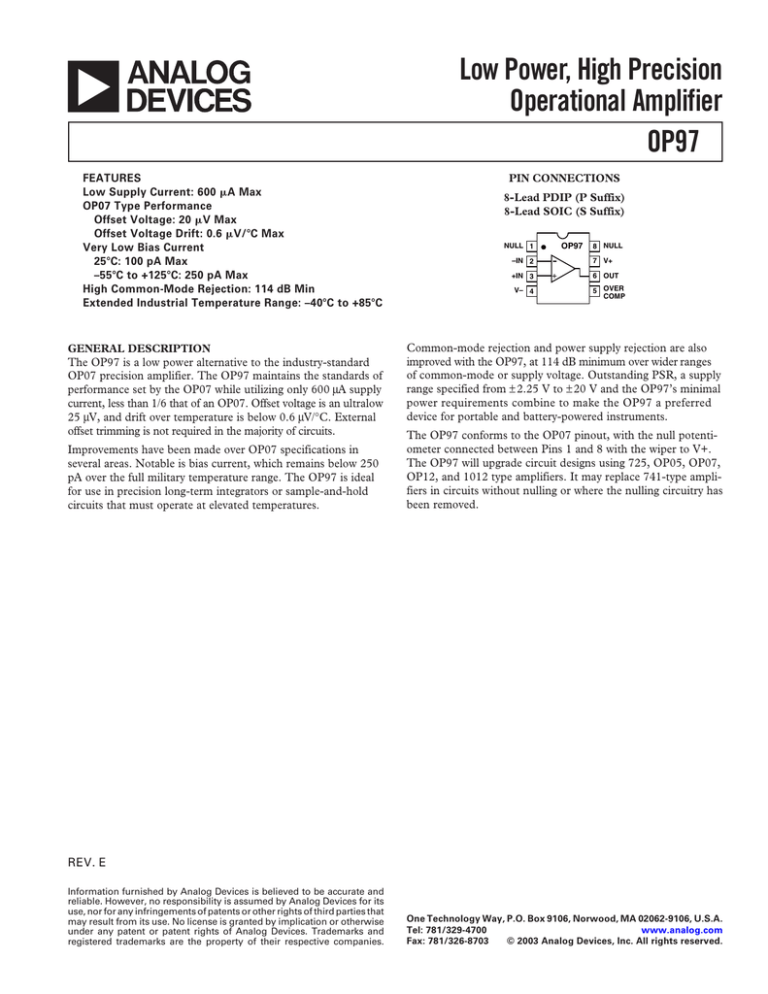
Low Power, High Precision
Operational Amplifier
OP97
FEATURES
Low Supply Current: 600 A Max
OP07 Type Performance
Offset Voltage: 20 V Max
Offset Voltage Drift: 0.6 V/ⴗC Max
Very Low Bias Current
25ⴗC: 100 pA Max
–55ⴗC to +125ⴗC: 250 pA Max
High Common-Mode Rejection: 114 dB Min
Extended Industrial Temperature Range: –40ⴗC to +85ⴗC
GENERAL DESCRIPTION
The OP97 is a low power alternative to the industry-standard
OP07 precision amplifier. The OP97 maintains the standards of
performance set by the OP07 while utilizing only 600 µA supply
current, less than 1/6 that of an OP07. Offset voltage is an ultralow
25 µV, and drift over temperature is below 0.6 µV/°C. External
offset trimming is not required in the majority of circuits.
Improvements have been made over OP07 specifications in
several areas. Notable is bias current, which remains below 250
pA over the full military temperature range. The OP97 is ideal
for use in precision long-term integrators or sample-and-hold
circuits that must operate at elevated temperatures.
PIN CONNECTIONS
8-Lead PDIP (P Suffix)
8-Lead SOIC (S Suffix)
NULL 1
OP97
8 NULL
–IN 2
7 V+
+IN 3
6 OUT
V– 4
5 OVER
COMP
Common-mode rejection and power supply rejection are also
improved with the OP97, at 114 dB minimum over wider ranges
of common-mode or supply voltage. Outstanding PSR, a supply
range specified from ± 2.25 V to ± 20 V and the OP97’s minimal
power requirements combine to make the OP97 a preferred
device for portable and battery-powered instruments.
The OP97 conforms to the OP07 pinout, with the null potentiometer connected between Pins 1 and 8 with the wiper to V+.
The OP97 will upgrade circuit designs using 725, OP05, OP07,
OP12, and 1012 type amplifiers. It may replace 741-type amplifiers in circuits without nulling or where the nulling circuitry has
been removed.
REV. E
Information furnished by Analog Devices is believed to be accurate and
reliable. However, no responsibility is assumed by Analog Devices for its
use, nor for any infringements of patents or other rights of third parties that
may result from its use. No license is granted by implication or otherwise
under any patent or patent rights of Analog Devices. Trademarks and
registered trademarks are the property of their respective companies.
One Technology Way, P.O. Box 9106, Norwood, MA 02062-9106, U.S.A.
Tel: 781/329-4700
www.analog.com
Fax: 781/326-8703
© 2003 Analog Devices, Inc. All rights reserved.
OP97–SPECIFICATIONS
ELECTRICAL CHARACTERISTICS
(@ VS = ⴞ15 V, VCM = 0 V, TA = 25ⴗC, unless otherwise noted.)
Conditions
Min
OP97E
Typ
Parameter
Symbol
Input Offset Voltage
Long-Term Offset
Voltage Stability
Input Offset Current
Input Bias Current
Input Noise Voltage
Input Noise Voltage Density
VOS
10
∆VOS/Time
IOS
IB
en p-p
en
Input Noise Current Density
Large-Signal Voltage Gain
Common-Mode Rejection
Power-Supply Rejection
Input Voltage Range3
Output Voltage Swing
Slew Rate
Differential Input Resistance4
Closed-Loop Bandwidth
Supply Current
Supply Voltage
in
AVO
CMR
PSR
IVR
VO
SR
RIN
BW
ISY
VS
0.3
30
± 30
0.5
17
14
20
2000
132
132
± 14.0
± 14
0.2
0.1 Hz to 10 Hz
fO = 10 Hz1
fO = 1000 Hz2
fO = 10 Hz
VO = ± 10 V; RL = 2 kΩ
VCM = ± 13.5 V
VS = ± 2 V to ± 20 V
RL = 10 kΩ
AVCL = 1
300
114
114
± 13.5
± 13
0.1
30
0.4
±2
Operating Range
0.9
380
± 15
Max
Min
25
30
100
± 100
30
22
200
110
110
± 13.5
± 13
0.1
30
0.4
600
± 20
OP97F
Typ
±2
0.3
30
± 30
0.5
17
14
20
2000
132
132
± 14.0
± 14
0.2
0.9
380
± 15
Max
Unit
75
µV
150
± 150
30
22
600
± 20
µV/Month
pA
pA
µV p-p
nV/√Hz
nV/√Hz
fA/√Hz
V/mV
dB
dB
V
V
V/µs
MΩ
MHz
µA
V
NOTES
1
10 Hz noise voltage density is sample tested. Devices 100% tested for noise are available on request.
2
Sample tested.
3
Guaranteed by CMR test.
4
Guaranteed by design.
Specifications subject to change without notice.
ELECTRICAL CHARACTERISTICS
(@ VS = ⴞ15 V, VCM = 0 V, –40ⴗC ≤ TA ≤ +85ⴗC for the OP97E/F, unless otherwise noted.)
Parameter
Symbol
Conditions
Input Offset Voltage
Average Temperature
Coefficient of VOS
Input Offset Current
Average Temperature
Coefficient of IOS
Input Bias Current
Average Temperature
Coefficient of IB
Large Signal Voltage Gain
Common-Mode Rejection
Power Supply Rejection
Input Voltage Range*
Output Voltage Swing
Slew Rate
Supply Current
Supply Voltage
VOS
TCVOS
S-Package
Min
OP97E
Typ
Max
250
2.5
750
7.5
pA
pA/°C
± 60
± 250
± 80
± 750
pA
0.4
1000
128
126
± 14.0
± 14
0.15
400
± 15
2.5
0.6
1000
128
128
± 14.0
± 14
0.15
400
± 15
7.5
pA/°C
V/mV
dB
dB
V
V
V/µs
µA
V
60
0.4
IB
RL = 10 kΩ
± 2.5
Operating Range
Unit
µV
µV/°C
IOS
TCIOS
200
108
108
± 13.5
± 13
0.05
Max
200
2.0
60
0.6
VO = 10 V; RL = 2 kΩ
VCM = ± 13.5 V
VS = ± 2.5 V to ± 20 V
OP97F
Typ
60
0.3
0.3
80
0.6
25
0.2
TCIB
AVO
CMR
PSR
IVR
VO
SR
ISY
VS
Min
150
108
108
± 13.5
± 13
0.05
800
± 20
± 2.5
800
± 20
*Guaranteed by CMR test.
Specifications subject to change without notice.
–2–
REV. E
OP97
ABSOLUTE MAXIMUM RATINGS 1
ORDERING GUIDE
Supply Voltage . . . . . . . . . . . . . . . . . . . . . . . . . . . . . . . . ± 20 V
Input Voltage2 . . . . . . . . . . . . . . . . . . . . . . . . . . . . . . . . ± 20 V
Differential Input Voltage3 . . . . . . . . . . . . . . . . . . . . . . . . ± 1 V
Differential Input Current3 . . . . . . . . . . . . . . . . . . . . ± 10 mA
Output Short-Circuit Duration . . . . . . . . . . . . . . . . Indefinite
Operating Temperature Range
OP97E, OP97F (P, S) . . . . . . . . . . . . . . . . . –40°C to +85°C
Storage Temperature Range . . . . . . . . . . . . –65°C to +150°C
Junction Temperature Range . . . . . . . . . . . . –65°C to +150°C
Lead Temperature (Soldering, 60 sec) . . . . . . . . . . . . . 300°C
Package Type
JA4
JC
Unit
8-Lead PDIP (P)
8-Lead SOIC (S)
103
158
43
43
°C/W
°C/W
Model
Temperature
Range
Package
Description
Package
Option*
OP97EP
OP97FP
OP97FS
OP97FS-REEL
OP97FS-REEL7
–40°C to +85°C
–40°C to +85°C
–40°C to +85°C
–40°C to +85°C
–40°C to +85°C
8-Lead PDIP
8-Lead PDIP
8-Lead SOIC
8-Lead SOIC
8-Lead SOIC
N-8
N-8
R-8
R-8
R-8
*For outline information, see Package Information section.
NOTES
1
Absolute maximum ratings apply to both DICE and packaged parts, unless
otherwise noted.
2
For supply voltages less than ± 20 V, the absolute maximum input voltage is equal
to the supply voltage.
3
The OP97’s inputs are protected by back-to-back diodes. Current-limiting resistors are not used in order to achieve low noise. Differential input voltages greater
than 1 V will cause excessive current to flow through the input protection diodes
unless limiting resistance is used.
4
JA is specified for worst-case mounting conditions, i.e., JA is specified for device
in socket for PDIP package; JA is specified for device soldered to printed circuit
board for SOIC package.
CAUTION
ESD (electrostatic discharge) sensitive device. Electrostatic charges as high as 4000 V readily
accumulate on the human body and test equipment and can discharge without detection. Although the
OP97 features proprietary ESD protection circuitry, permanent damage may occur on devices
subjected to high energy electrostatic discharges. Therefore, proper ESD precautions are recommended
to avoid performance degradation or loss of functionality.
REV. E
–3–
OP97–Typical Performance Characteristics
VS = ⴞ15V
TA = 25ⴗC
VCM = 0V
1894 UNITS
VS = ⴞ15V
TA = 25ⴗC
VCM = 0V
1920 UNITS
VS = ⴞ15V
TA = 25ⴗC
VCM = 0V
1894 UNITS
400
NUMBER OF UNITS
200
NUMBER OF UNITS
300
300
NUMBER OF UNITS
500
400
400
200
300
200
100
100
100
0
–40
–20
0
20
INPUT OFFSET VOLTAGE (V)
0
–100
40
40
20
IB+
0
–20
IOS
INPUT CURRENT (pA)
IB–
DEVIATION FROM FINAL VALUE (V)
40
IB–
20
IB+
0
IOS
–20
–40
–40
–50 –25
0
25
50
75
100
–60
–15
125
TEMPERATURE ( C)
1000
BALANCED OR UNBALANCED
VS = ⴞ15V
VCM = 0V
100
–55ⴗC
TA
+125ⴗC
TA = 25ⴗC
10
1
1k
3k
10k 30k 100k 300k 1M 3M 10M
SOURCE RESISTANCE (⍀)
TPC 7. Effective Offset Voltage vs. Source Resistance
ⴞ4
ⴞ3
ⴞ2
J PACKAGES
ⴞ1
Z, P PACKAGES
15
0
TPC 5. Input Bias, Offset Current vs.
Common-Mode Voltage
EFFECTIVE OFFSET VOLTAGE DRIFT (V/ C)
TPC 4. Input Bias, Offset
Current vs. Temperature
TA = 25ⴗC
VS = ⴞ15V
VCM = 0V
0
–10
–5
0
5
10
COMMON-MODE VOLTAGE (V)
2
3
4
5
1
TIME AFTER POWER APPLIED (Minutes)
TPC 6. Input Offset Voltage
Warm-Up Drift
20
100
BALANCED OR UNBALANCED
VS = ⴞ15V
VCM = 0V
SHORT-CIRCUIT CURRENT (mA)
–60
–75
60
ⴞ5
TA = 25ⴗC
VS = ⴞ15V
TA = 25ⴗC
VCM = 0V
–20
0
20
40
–40
INPUT OFFSET CURRENT (pA)
TPC 3. Typical Distribution of
Input Offset Current
60
60
INPUT CURRENT (pA)
0
–60
100
TPC 2. Typical Distribution of
Input Bias Current
TPC 1. Typical Distribution of
Input Offset Voltage
EFFECTIVE OFFSET VOLTAGE (V)
–50
0
50
INPUT BIAS CURRENT (pA)
10
1
0.1
1k
TA = –55ⴗC
15
TA = +25ⴗC
10
TA = +125ⴗC
5
VS = ⴞ15V
OUTPUT SHORTED TO GROUND
0
–5
TA = +125ⴗC
–10
TA = +25ⴗC
–15
TA = –55ⴗC
–20
10k
100k
1M
10M
SOURCE RESISTANCE (⍀)
TPC 8. Effective TCVOS vs.
Source Resistance
–4–
100M
0
1
2
TIME FROM OUTPUT SHORT (Minutes)
3
TPC 9. Short-Circuit Current
vs. Time, Temperature
REV. E
OP97
450
140
140
COMMON-MODE REJECTION (dB)
400
TA = +125ⴗC
TA = +25ⴗC
TA = –55ⴗC
325
300
ⴞ10
ⴞ15
ⴞ5
SUPPLY VOLTAGE (V)
0
60
40
20
1
100
1k
10k
FREQUENCY (Hz)
100k
1M
TA = –55ⴗC
TA = +25ⴗC
1000
TA = +125ⴗC
VOLTAGE NOISE DENSITY (nV/ Hz)
VS = ⴞ15V
VO = ⴞ10V
1000
TA = 25ⴗC
VS = ⴞ2V TO ⴞ20V
100
100
CURRENT NOISE
VOLTAGE NOISE
10
10
1/f CORNER
2.5Hz
1/f CORNER
120Hz
1
100
1
2
5
10
LOAD RESISTANCE (k⍀)
1
20
–PSR
80
+PSR
60
40
10
100
FREQUENCY (Hz)
OUTPUT SWING (V p-p)
TA = +25ⴗC
1M
TA = 25ⴗC
VS = ⴞ2V TO ⴞ20V
1kHz
10Hz
1
R
R
RS = 2R
0.1
10Hz
1kHz
0.01
102
103
104
105
106
107
SOURCE RESISTANCE (⍀)
108
TPC 15. Total Noise Density
vs. Source Resistance
35
TA = 25ⴗC
VS = ⴞ15V
AVCL = +1
1% THD
fO = 1kHz
30
TA = +125ⴗC
100k
RESISTOR NOISE
1
1000
35
RL = 10k⍀
VS = ⴞ15V
VCM = 0V
10
100 1k
10k
FREQUENCY (Hz)
1
10
TPC 14. Noise Density vs.
Frequency
TPC 13. Open-Loop Gain vs.
Load Resistance
DIFFERENTIAL INPUT VOLTAGE (10V/DIV)
100
TPC 12. Power-Supply
Rejection vs. Frequency
1000
10000
120
TPC 11. Common-Mode
Rejection vs. Frequency
TPC 10. Supply Current vs.
Supply Voltage
OPEN-LOOP GAIN (V/mV)
10
TA = 25ⴗC
VS = ⴞ15V
⌬VS = 10V p–p
20
0.1
0
ⴞ20
TOTAL NOISE DENSITY (V/ Hz)
350
80
CURRENT NOISE DENSITY (FA/ Hz)
375
100
25
TA = 25ⴗC
VS = ⴞ15V
AVCL = 1
1% THD
Rl = 10k⍀
30
OUTPUT SWING (V p-p)
SUPPLY CURRENT (A)
425
120
POWER-SUPPLY REJECTION (dB)
TA = 25ⴗC
VS = ⴞ15V
VCM = ⴞ10V
NO LOAD
20
15
10
5
25
20
15
10
5
TA = –55ⴗC
–15
–10
–5
0
5
10
OUTPUT VOLTAGE (V)
TPC 16. Open-Loop Gain
Linearity
REV. E
15
1
10
100
1k
LOAD RESISTANCE (⍀)
TPC 17. Maximum Output
Swing vs. Load Resistance
–5–
10k
1
100
10k
1k
FREQUENCY (Hz)
TPC 18. Maximum Output
Swing vs. Frequency
100k
OP97
10
70
GAIN
TA = 25ⴗC
VS = ⴞ15V
RL = 10k⍀
1% THD
VOUT = 3V RMS
90
135
20
TA = +125ⴗC
TA = –55ⴗC
0
225
V
15V
S=
VS
= ⴞ15V
TA = –55ⴗC
C
L=
= 20pF
20pF
CL
TA = +125ⴗC
RL =
= 1M⍀
1M⍀
R
L
100pF OVERCOMPENSATION
OVERCOMPENSATION
100pF
–60
100
1k
10k
100k
FREQUENCY (Hz)
1M
AVCL = 100
0.01
AVCL = 10
AVCL = 1
0.0001
10
10M
TPC 19. Open-Loop Gain, Phase vs.
Frequency (COC = 0 pF)
180
225
–20
–40
–60
100
VS = ⴞ15V
TA = +125ⴗC
CL = 20pF
TA = –55ⴗC
RL = 1M⍀
100pF OVERCOMPENSATION
10k
100k
FREQUENCY (Hz)
1M
TA = –55ⴗC
0.1
0.01
10M
TPC 22. Open-Loop Gain, Phase vs.
Frequency (COC = 100 pF)
0
GAIN
135
TA = –55ⴗC
TA = +125ⴗC
180
225
–20
–40
–60
100
VS = ⴞ15V
CL = 20pF
RL = 1M⍀
100pF OVERCOMPENSATION
1k
10k
100k
FREQUENCY (Hz)
OPEN-LOOP GAIN (dB)
20
PHASE SHIFT (Degrees)
PHASE
10M
TPC 25. Open-Loop Gain, Phase vs.
Frequency (COC = 1000 pF)
TA = 25ⴗC
VS = ⴞ15V
100
90
PHASE
0
135
GAIN
180
TA = +125ⴗC
TA = –55ⴗC
–20
–40
1M
1000
40
20
–60
100
10
100
10000
1000
OVERCOMPENSATION CAPACITOR (pF)
TPC 24. Gain Bandwidth Product vs.
Overcompensation
TA = –55ⴗC
TA = +25ⴗC
TA = +125ⴗC
60
90
40
VS = ⴞ15V
CL = 20pF
RL = 1M⍀
AV = 100
1
80
60
10
10
100
10000
1000
OVERCOMPENSATION CAPACITOR (pF)
TPC 23. Slew Rate vs.
Overcompensation
TA = –55ⴗC
TA = +25ⴗC
TA = +125ⴗC
TA = +125ⴗC
100
1
1
80
10000
100
1000
LOAD CAPACITANCE (pF)
TA = –55ⴗC
0.001
1k
20
TPC 21. Small Signal Overshoot vs.
Capacitive Load
GAIN BANDWIDTH (kHz)
0
TA = –55ⴗC
TA = +125ⴗC
SLEW RATE (V/s)
135
20
PHASE SHIFT (Degrees)
OPEN-LOOP GAIN (dB)
90
30
Rl = 10k⍀
VS = ⴞ15V
CL = 100pF
TA = +125ⴗC
PHASE
–EDGE
1000
60
40
+EDGE
40
0
10
10k
1
GAIN
OPEN-LOOP GAIN (dB)
100
1k
FREQUENCY (Hz)
TPC 20. Total Harmonic Distortion
Plus Noise vs. Frequency
80
50
10
225
VS = ⴞ15V
CL = 20pF
RL = 1M⍀
100pF OVERCOMPENSATION
1k
10k
100k
FREQUENCY (Hz)
10
AVCL = 1000
1
AVCL = 1
0.1
0.01
1M
10M
TPC 26. Open-Loop Gain, Phase vs.
Frequency (COC = 10,000 pF)
–6–
OUTPUT IMPEDANCE (⍀)
–40
0.1
0.001
TA = 25ⴗC
VS = ⴞ15V
AVCL = +1
VOUT = 100mV p-p
COC = 0pF
60
PHASE SHIFT (Degrees)
–20
180
THD + N (%)
1
PHASE
40
PHASE SHIFT (Degrees)
OPEN-LOOP GAIN (dB)
60
OVERSHOOT (%)
80
0.001
1
10
100
1k
FREQUENCY (Hz)
10k
100k
TPC 27. Closed-Loop Output
Resistance vs. Frequency
REV. E
OP97
as ± 2 V. Typically, the common-mode range extends to within
1 V of either rail. The output typically swings to within 1 V of
the rails when using a 10 kΩ load.
APPLICATION INFORMATION
The OP97 is a low power alternative to the industry-standard
precision op amp, the OP07. The OP97 may be substituted
directly into OP07, OP77, 725, 112/312, and 1012 sockets with
improved performance and/or less power dissipation and may be
inserted into sockets conforming to the 741 pinout if nulling
circuitry is not used. Generally, nulling circuitry used with earlier generation amplifiers is rendered superfluous by the OP97’s
extremely low offset voltage and may be removed without compromising circuit performance.
Offset nulling is achieved utilizing the same circuitry as an OP07.
A potentiometer between 5 kΩ and 100 kΩ is connected between
Pins 1 and 8 with the wiper connected to the positive supply.
The trim range is between 300 µV and 850 µV, depending upon
the internal trimming of the device.
AC PERFORMANCE
Extremely low bias current over the full military temperature
range makes the OP97 attractive for use in sample-and-hold
amplifiers, peak detectors, and log amplifiers that must operate
over a wide temperature range. Balancing input resistances is
not necessary with the OP97. Offset voltage and TCVOS are
degraded only minimally by high source resistance, even when
unbalanced.
The OP97’s ac characteristics are highly stable over its full
operating temperature range. Unity-gain small-signal response
is shown in Figure 2. Extremely tolerant of capacitive loading
on the output, the OP97 displays excellent response even with
1000 pF loads (Figure 3). In large-signal applications, the input
protection diodes effectively short the input to the output during
the transients if the amplifier is connected in the usual unitygain configuration. The output enters short-circuit current limit,
with the flow going through the protection diodes. Improved
large-signal transient response is obtained by using a feedback
resistor between the output and the inverting input. Figure 4
shows the large-signal response of the OP97 in unity gain with a
10 kΩ feedback resistor. The unity-gain follower circuit is shown
in Figure 5.
The input pins of the OP97 are protected against large differential
voltage by back-to-back diodes. Current-limiting resistors are
not used so that low noise performance is maintained. If differential voltages above ± 1 V are expected at the inputs, series
resistors must be used to limit the current flow to a maximum of
10 mA. Common-mode voltages at the inputs are not restricted
and may vary over the full range of the supply voltages used.
The overcompensation pin may be used to increase the phase
margin of the OP97 or to decrease gain-bandwidth product at
gains greater than 10.
The OP97 requires very little operating headroom about the
supply rails and is specified for operation with supplies as low
+V
RPOT = 5k⍀ TO 100k⍀
OP97
COC
–V
Figure 1. Optional Input Offset Voltage Nulling
and Overcompensation Circuits
Figure 3. Small-Signal Transient Response
(CLOAD = 1000 pF, AVCL = 1)
Figure 2. Small-Signal Transient Response
(CLOAD = 100 pF, AVCL = 1)
REV. E
Figure 4. Large-Signal Transient Response (AVCL = 1)
–7–
OP97
10k⍀
30pF
RFB
IO
2
OP97
VIN
2
6
OP97
PM7548
6
VOUT
3
VOUT
IO
3
DIGITAL
INPUTS
Figure 5. Unity-Gain Follower
Figure 7. DAC Output Amplifier
R1
10k⍀
IL
V1
R2
10k⍀
R5
10k⍀
R3
10k⍀
RL
+15V
2
7
6
OP97
3
R4
10k⍀
Figure 6. Small-Signal Transient Response with Overcompensation (CLOAD = 1000 pF, AVCL = 1, COC = 220 pF)
VOUT
4
–15V
Figure 8. Current Monitor
GUARDING AND SHIELDING
To maintain the extremely high input impedances of the OP97,
care must be taken in circuit board layout and manufacturing.
Board surfaces must be kept scrupulously clean and free of
moisture. Conformal coating is recommended to provide a
humidity barrier. Even a clean PC board can have 100 pA of
leakage currents between adjacent traces, so that guard rings
should be used around the inputs. Guard traces are operated at
a voltage close to that on the inputs, so that leakage currents
become minimal. In noninverting applications, the guard ring
should be connected to the common-mode voltage at the inverting input (Pin 2). In inverting applications, both inputs remain
at ground, so that the guard trace should be grounded. Guard
traces should be made on both sides of the circuit board.
High impedance circuitry is extremely susceptible to RF pickup,
line frequency hum, and radiated noise from switching power
supplies. Enclosing sensitive analog sections within grounded
shields is generally necessary to prevent excessive noise pickup.
Twisted-pair cable will aid in rejection of line frequency hum.
The OP97 is an excellent choice as an output amplifier for
higher resolution CMOS DACs. Its tightly trimmed offset voltage and minimal bias current result in virtually no degradation
of linearity, even over wide temperature ranges.
Figure 8 shows a versatile monitor circuit that can typically
sense current at any point between the ± 15 V supplies. This
makes it ideal for sensing current in applications such as full
bridge drivers where bidirectional current is associated with
large common-mode voltage changes. The 114 dB CMRR of
the OP97 makes the amplifier’s contribution to common-mode
error negligible, leaving only the error due to the resistor ratio
inequality. Ideally, R2/R4 = R3/R5.
UNITY-GAIN FOLLOWER
NONINVERTING AMPLIFIER
2
2
OP97
6
6
OP97
3
3
PDIP
BOTTOM VIEW
INVERTING AMPLIFIER
8
2
OP97
1
6
3
Figure 9. Guard Ring Layout and Connections
–8–
REV. E
OP97
The digitally programmable gain amplifier shown in Figure 10
has 12-bit gain resolution with 10-bit gain linearity over the
range of –1 to –1024. The low bias current of the OP97 maintains this linearity, while C1 limits the noise voltage bandwidth
allowing accurate measurement down to microvolt levels.
DIGITAL IN
R2
20k⍀
5pF
VIN
R1
2k⍀
1F
2
10k⍀
GAIN (Av)
10k⍀
4095
2048
1024
512
256
128
64
32
16
8
4
2
1
0
–1.00024
–2
–4
–8
–16
–32
–64
–128
–256
–512
–1024
–2048
–4096
Open Loop
18
VREF
Figure 12. Combination Amplifier Transient Response
17
2
3
IOUT 2
PM7541
C1
220pF
+15V
2
0.1F
OP97
6
VOUT
3
0.1F
–15V
Figure 10. Precision Programmable Gain Amplifier
REV. E
R2
R1
Figure 11. Combination High-Speed, Precision Amplifier
RFB
IOUT 1
AV =
5
0.1F
0.1F
16
6
OP97
3
+15V
VIN
VOUT
3
2
Many high speed amplifiers suffer from less-than-perfect low
frequency performance. A combination amplifier consisting of a
high precision, slow device like the OP97 and a faster device
such as the OP44 results in uniformly accurate performance
from dc to the high frequency limit of the OP44, which has a
gain-bandwidth product of 23 MHz. The circuit shown in
Figure 11 accomplishes this, with the OP44 providing high
frequency amplification and the OP97 operating on low frequency signals and providing offset correction. Offset voltage
and drift of the circuit are controlled by the OP97.
ⴞ2.5mV TO ⴞ10V
RANGE DEPENDING
ON GAIN SETTING
1
6
OP44
–9–
OP97
OUTLINE DIMENSIONS
8-Lead Plastic Dual In-Line Package [PDIP]
P-Suffix
(N-8)
Dimensions shown in inches and (millimeters)
0.375 (9.53)
0.365 (9.27)
0.355 (9.02)
8
5
1
4
0.295 (7.49)
0.285 (7.24)
0.275 (6.98)
0.325 (8.26)
0.310 (7.87)
0.300 (7.62)
0.100 (2.54)
BSC
0.015
(0.38)
MIN
0.180
(4.57)
MAX
0.150 (3.81)
0.130 (3.30)
0.110 (2.79)
0.022 (0.56)
0.018 (0.46)
0.014 (0.36)
0.150 (3.81)
0.135 (3.43)
0.120 (3.05)
0.015 (0.38)
0.010 (0.25)
0.008 (0.20)
SEATING
PLANE
0.060 (1.52)
0.050 (1.27)
0.045 (1.14)
COMPLIANT TO JEDEC STANDARDS MO-095AA
CONTROLLING DIMENSIONS ARE IN INCHES; MILLIMETER DIMENSIONS
(IN PARENTHESES) ARE ROUNDED-OFF INCH EQUIVALENTS FOR
REFERENCE ONLY AND ARE NOT APPROPRIATE FOR USE IN DESIGN
8-Lead Standard Small Outline Package [SOIC]
Narrow Body
S-Suffix
(R-8)
Dimensions shown in millimeters and (inches)
5.00 (0.1968)
4.80 (0.1890)
4.00 (0.1574)
3.80 (0.1497)
8
5
1
4
1.27 (0.0500)
BSC
0.25 (0.0098)
0.10 (0.0040)
COPLANARITY
SEATING
0.10
PLANE
6.20 (0.2440)
5.80 (0.2284)
1.75 (0.0688)
1.35 (0.0532)
0.51 (0.0201)
0.31 (0.0122)
0.50 (0.0196)
ⴛ 45ⴗ
0.25 (0.0099)
8ⴗ
0.25 (0.0098) 0ⴗ 1.27 (0.0500)
0.40 (0.0157)
0.17 (0.0067)
COMPLIANT TO JEDEC STANDARDS MS-012AA
CONTROLLING DIMENSIONS ARE IN MILLIMETERS; INCH DIMENSIONS
(IN PARENTHESES) ARE ROUNDED-OFF MILLIMETER EQUIVALENTS FOR
REFERENCE ONLY AND ARE NOT APPROPRIATE FOR USE IN DESIGN
–10–
REV. E
OP97
Revision History
Location
Page
7/03—Data Sheet changed from REV. D to REV. E.
Deleted H-08A . . . . . . . . . . . . . . . . . . . . . . . . . . . . . . . . . . . . . . . . . . . . . . . . . . . . . . . . . . . . . . . . . . . . . . . . . . . . . . . . . . .Universal
Deleted Q-8 . . . . . . . . . . . . . . . . . . . . . . . . . . . . . . . . . . . . . . . . . . . . . . . . . . . . . . . . . . . . . . . . . . . . . . . . . . . . . . . . . . . . . .Universal
Deleted E-20A . . . . . . . . . . . . . . . . . . . . . . . . . . . . . . . . . . . . . . . . . . . . . . . . . . . . . . . . . . . . . . . . . . . . . . . . . . . . . . . . . . . .Universal
Deleted DIE CHARACTERISTICS . . . . . . . . . . . . . . . . . . . . . . . . . . . . . . . . . . . . . . . . . . . . . . . . . . . . . . . . . . . . . . . . . . . . . . . . . 4
Deleted WAFER TEST LIMITS . . . . . . . . . . . . . . . . . . . . . . . . . . . . . . . . . . . . . . . . . . . . . . . . . . . . . . . . . . . . . . . . . . . . . . . . . . . 4
Updated TPC 14 . . . . . . . . . . . . . . . . . . . . . . . . . . . . . . . . . . . . . . . . . . . . . . . . . . . . . . . . . . . . . . . . . . . . . . . . . . . . . . . . . . . . . . . . 5
Updated OUTLINE DIMENSIONS . . . . . . . . . . . . . . . . . . . . . . . . . . . . . . . . . . . . . . . . . . . . . . . . . . . . . . . . . . . . . . . . . . . . . . . 10
1/02—Data Sheet changed from REV. C to REV. D.
Edits to Absolute Maximum Ratings . . . . . . . . . . . . . . . . . . . . . . . . . . . . . . . . . . . . . . . . . . . . . . . . . . . . . . . . . . . . . . . . . . . . . . . . . 3
Edits to Ordering Guide . . . . . . . . . . . . . . . . . . . . . . . . . . . . . . . . . . . . . . . . . . . . . . . . . . . . . . . . . . . . . . . . . . . . . . . . . . . . . . . . . . 3
Deleted DICE CHARACTERISTICS . . . . . . . . . . . . . . . . . . . . . . . . . . . . . . . . . . . . . . . . . . . . . . . . . . . . . . . . . . . . . . . . . . . . . . . 3
Deleted WAFER TEST LIMITS . . . . . . . . . . . . . . . . . . . . . . . . . . . . . . . . . . . . . . . . . . . . . . . . . . . . . . . . . . . . . . . . . . . . . . . . . . . 3
Edits to APPLICATION INFORMATION . . . . . . . . . . . . . . . . . . . . . . . . . . . . . . . . . . . . . . . . . . . . . . . . . . . . . . . . . . . . . . . . . . . 7
REV. E
–11–
–12–
C00299–0–7/03(E)





